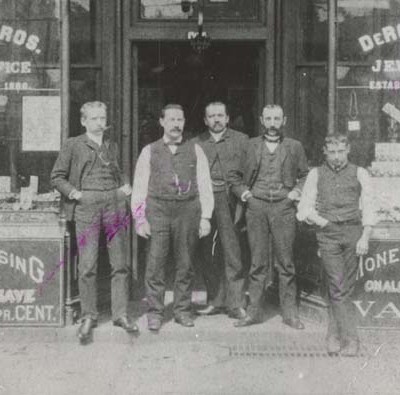
Abraham Levie DeRoy (1808-1889) and his wife Saartje Israel “Sarah” van Baalen DeRoy (1812-1896) lived in Amsterdam and had seven children, Sam, Levy, Emanuel, Betsy, Israel, Joseph and Kate. The family immigrated to Pittsburgh in the 1850s.
The sons went into various lines of work in the retail industry but found their greatest success as pawnbrokers. While various historical accounts disagree on the precise dates, Israel and Joseph DeRoy started DeRoy Brothers, a shop in the first floor of a house at 49 Smithfield Street, downtown, about 1870. The brothers eventually parted ways and opened separate downtown jewelry stores, Jos. DeRoy & Sons and Israel DeRoy & Son.
Joseph DeRoy (1850-1918) married Lydia Isaacs (1852-1911) of Pennsylvania. They had eight children, Abraham, Albert, Louis, Catherine, Sarah, Isaac, Israel and Julia.
Joseph DeRoy was the vice-president of the J. M. Gusky Home and Orphanage. To help the orphanage raise money during a depression, DeRoy and several others ran a refreshment stand in Schenley Park one day in July 1894, earning about $500. The sons of Joseph and Lydia Deroy donated a “memorial annex” to the Perrysville Avenue home in memory of their parents.
Israel DeRoy (1847-1935) married Catherine “Kitty” DeHaan (1852-1935) of Pennsylvania. They had ten children, Abraham, Louis, Joseph Israel, Aaron, Samuel, Rachel, Harry, Emanuel and Monas. Abraham and Emanuel both worked for their father for a time, and Louis opened another jewelry business further down on Smithfield Street. The other sons went into different professions.
Aaron DeRoy (1880-1935) was one of the first Jewish automobile dealers in Pittsburgh, with offices near Forbes Field in Oakland. He moved to Detroit, where he led industry groups and sat on the board the Hudson Motor Company. He died in a car accident.
After attending the University of Philadelphia, Joseph Israel DeRoy (1874-1934) practiced dentistry in Pittsburgh. He married Bessie Leyser (1889-1980), of Greenville, Mississippi, who had studied etching at the University of Pittsburgh and was a talented seamstress. They lived in Squirrel Hill and had two daughters, Helen Louise and Aaronel.
Aaronel deRoy (1918-2011), who capitalized her surname differently than other members of the family, showed an interest in drawing from an early age. While pursuing a degree in science at the Carnegie Institute of Technology, she found time to take art classes with noted professors such as Robert Lepper and Samuel Rosenberg. Among her classmates was a young Rochelle Reznik.
Aaronel deRoy met Irving Gruber at a fraternity party. They married in 1940. For a short time, she worked as a fashion coordinator at Kaufmann’s Department Store. Irv Gruber began his career in the steel industry, eventually owning the American Forge and Manufacturing Company. They lived Squirrel Hill with their children, Jon, Jamie and Terry. For many years, Irv Gruber had a regular poker game with Allen Berkman, Louis Blum and Alexander Speyer Jr.
As a member of the abstract art collective “Group A,” Aaronel deRoy Gruber continued studying with Rosenberg. She initially painted abstract canvases. “I paint from everyday experiences and emotions: joy and sorrow, forms of the city, or drama at midnight, the dynamics of space, and the power of machinery,” she wrote in an early statement. “I paint what I know and feel about life extracting the essence into my own abstract images.”
Influenced by a friendship with the American abstract sculptor Dave Smith, deRoy Gruber began sculpting in the 1960s. Making use of scrap material available to her through her husband, deRoy Gruber constructed large steel works, including Steelcityscape, a tower of rounded squares. The piece is installed in Mellon Park.
Soon, deRoy Gruber began exploring Plexiglas. Using space at an industrial facility on Ardmore Boulevard, she perfected techniques for molding the plastic material. She gained wide acclaim in the 1970s and 1980s for Plexiglas works incorporating translucent colors and motorized elements. “I like its transparency, the overlapping of colors forming other colors and the effect of contained life within. When the sculpture is motorized, it takes on a life of its own,” she said. “It is one thing by day and another by night.” The Pittsburgh Center for the Arts named deRoy Gruber its Artist of the Year in 1981.
In her later years, deRoy Gruber turned to photography. She photographed landscapes and cityscapes, and invigorated these familiar images by using unexpected perspectives and odd colorations. She once wrote: “An artist who doesn’t change is lost by change.”
Her cousin Mayer DeRoy was the Pittsburgh chief of police from 1990 to 1992.